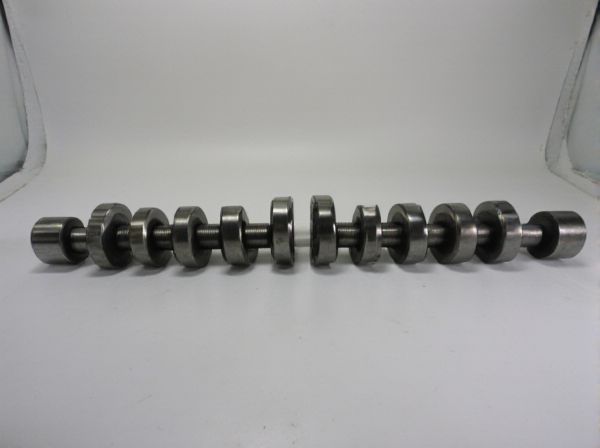
Photo illustration: Split Duration Camshaft vs Single Pattern Camshaft
Split duration camshafts offer varied valve opening times for intake and exhaust, enhancing engine efficiency and performance by optimizing airflow at different RPM ranges. Single pattern camshafts maintain uniform valve timings, providing simpler design and consistent power delivery but may sacrifice some tuning flexibility. Choosing the right camshaft depends on your engine goals, balancing complexity and performance needs.
Table of Comparison
| Feature | Split Duration Camshaft | Single Pattern Camshaft |
|---|---|---|
| Valve Timing | Different intake and exhaust durations | Same duration for intake and exhaust |
| Performance | Optimized for higher power and efficiency | Balanced but less specialized performance |
| Emissions | Better control, lower emissions | Standard emissions control |
| Complexity | More complex design and manufacturing | Simpler, easier to produce |
| Cost | Higher due to advanced features | Lower, budget-friendly option |
| Application | Performance and racing engines | Everyday and economy engines |
Introduction to Camshaft Designs
Split duration camshafts feature different lobe profiles for intake and exhaust valves, optimizing valve timing for enhanced engine performance and efficiency. Single pattern camshafts utilize identical lobe profiles for all valves, simplifying manufacturing and maintenance while providing consistent valve operation. Understanding these camshaft designs is essential for balancing power output, fuel economy, and engine reliability.
What is a Single Pattern Camshaft?
A Single Pattern Camshaft features identical cam lobe profiles on both intake and exhaust valves, offering uniform valve timing and lift throughout the engine cycle. This design simplifies manufacturing and tuning but may sacrifice some performance optimization when compared to Split Duration Camshafts. Single Pattern Camshafts are commonly used in engines where reliability and cost-efficiency are prioritized over maximizing power output.
Understanding Split Duration Camshafts
Split duration camshafts feature separate lobes with different timing profiles for the intake and exhaust valves, improving valve control for enhanced engine performance. These camshafts optimize valve overlap, boost torque at various RPM ranges, and enhance fuel efficiency by tailoring valve events to specific combustion needs. Compared to single pattern camshafts, split duration designs offer greater flexibility in tuning and dynamic engine response for high-performance and racing applications.
Key Differences: Split vs Single Pattern
Split duration camshafts feature separate lobes with distinct timing for intake and exhaust valves, enabling more precise control over valve events and improving engine efficiency and power output. Single pattern camshafts use identical lobes for both intake and exhaust valves, resulting in synchronized valve timing that simplifies design but may limit performance optimization. The key difference lies in the tailored valve timing flexibility of split duration cams versus the uniform timing of single pattern cams, impacting engine breathing characteristics and tuning potential.
Performance Impact of Split Duration Camshafts
Split duration camshafts enhance engine performance by optimizing valve timing for different RPM ranges, improving both low-end torque and high-end power. Unlike single pattern camshafts, they provide variable intake and exhaust timing, enabling better airflow and fuel combustion efficiency across a broader spectrum. This results in increased horsepower, improved throttle response, and more versatile engine characteristics ideal for varied driving conditions.
Advantages of Single Pattern Camshafts
Single pattern camshafts offer enhanced manufacturing simplicity and cost efficiency due to uniform lobe design, making them easier to produce and maintain. Their consistent timing across all cylinders leads to improved engine smoothness and predictable performance, reducing mechanical complexity and potential timing errors. This uniformity also supports better reliability and durability in various engine operating conditions compared to split duration camshafts.
Applications: Street vs Racing Engines
Split duration camshafts enable finer control over valve events, making them ideal for racing engines where precise timing adjustments maximize high-RPM power and efficiency. Single pattern camshafts, with uniform timing across cylinders, provide consistent performance and durability favored in street engines for smooth idling and fuel economy. Racing applications benefit from the flexibility of split duration cams to optimize power bands, whereas street engines prioritize reliability and emission compliance using single pattern cams.
Tuning Considerations for Each Camshaft Type
Split duration camshafts offer greater flexibility in tuning by allowing independent adjustment of intake and exhaust durations, optimizing valve timing for specific engine performance targets such as improved mid-range torque or high-RPM power. Single pattern camshafts provide a more straightforward tuning process with fixed timing events, usually favoring overall simplicity and durability but limiting customization for specialized performance needs. Understanding the engine's application and desired powerband is critical when choosing between split duration camshafts and single pattern camshafts for effective tuning optimization.
Common Misconceptions
Split duration camshafts and single pattern camshafts are often misunderstood in terms of their impact on engine performance; many assume split duration cams solely improve high RPM power, but they also enhance mid-range torque through precise valve timing adjustments. Another common misconception is that single pattern camshafts are outdated or less efficient, whereas they provide simpler tuning and consistent performance across varying engine speeds. Properly distinguishing their effects on valve lift, duration, and overlap is key to optimizing engine efficiency and power delivery.
Choosing the Right Camshaft for Your Build
Choosing the right camshaft between a split duration camshaft and a single pattern camshaft depends on your engine's performance goals and operating range. Split duration camshafts offer better mid-to-high RPM power by optimizing valve timing for different lobes, making them ideal for race or high-performance builds. Single pattern camshafts provide more consistent valve timing, improving low-end torque and drivability, which suits street or daily driver engines.
 caratoz.com
caratoz.com